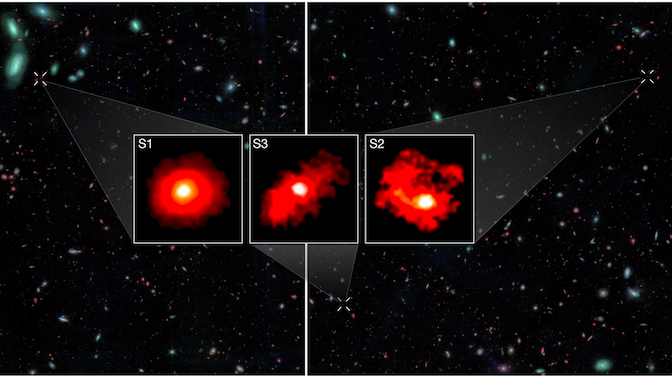
For a long time, astronomers believed galaxy formation followed a very specific model: cosmic gas collects in clumps, stars are born from those clumps, and, over billions of years, stellar neighborhoods gradually increase in size. However, the James Webb Space Telescope, launched in December 2021, has disrupted that model.
In a new study, scientists identified three massive galaxies — dubbed "Red Monsters" — each almost the size of the Milky Way, already in existence just one billion years after the Big Bang. Though that sounds like a really long time, in our 14-billion-year-old universe, just a billion years is relatively early on. These galaxies therefore raise a fundamental question: how did they grow so large, so quickly?
When astronomers initially examined the early universe using the James Webb Space Telescope, they expected to find galaxies in the early universe that weren't fully developed, but were surprised to discover not only fully-fledged ones, but also massive ones. This "crisis in cosmology" suggested a need to reevaluate our understanding of the universe's evolution since the Big Bang. However, there is a wrench in the tale.
In August, scientists found that these galaxies may appear larger and brighter due to having actively feeding black holes, leading to the conclusion that the unexpectedly "massive" galaxies are actually less massive than previously believed. Yet interestingly, this new study revealed no evidence of what are known as "active galactic nuclei (AGNs)" in these galaxies, ruling out the possibility that their intense emissions come from supermassive black holes at their centers.
Therefore, the crew concluded that the extreme characteristics of these galaxies — high mass and rapid star formation — are inherent to the galaxies themselves, and not driven by an active nucleus. How could this be?
The study was led by an international team at the University of Geneva (UNIGE) and utilized data from the FRESCO survey of the JWST. It focused on galaxies with redshift values between z = 5 and z = 9, when the universe was only 1 billion to 1.5 billion years old. Redshift measures how much wavelengths of light coming from distant objects stretch on their way to our detectors due to the expanding universe, with higher values indicating greater distance and age. The team used the FRESCO's Near Infrared Camera (NIRCam) grism spectrograph to measure the galaxies' distances and stellar masses.
"The instrument on board the space telescope allows us to identify and study the growth of galaxies over time, and to obtain a clearer picture of how stellar mass accumulates over the course of cosmic history," explained Pascal Oesch, associate professor at UNIGE Faculty of Science and principal investigator of this observation program, said in a statement.
The team's analysis centered on 36 massive, dusty, star-forming galaxies, selected for their unique red color and prominent emission lines, indicating they are massive and significantly obscured by dust. While most galaxies matched theoretical models of galaxy formation, three were categorized as "ultramassive" and had unusually high star formation rates.
The three Red Monsters appear red in the JWST's images due to their large dust content, which makes them absorb shorter wavelengths of light and scatter the remaining light into longer, reddish wavelengths. The JWST can observe them so clearly because it captures infrared light, enabling scientists to see past the dust, unlike the Hubble Space Telescope, which is limited to optical light. This ability to see through cosmic dust is one of the reasons JWST has revolutionized our view of the universe.
Returning to those Red Monsters, the new JWST data showed that these galaxies produce stars at about two to three times more efficiently than galaxies in the later universe.
The stellar masses of these three galaxies are so large that they require a stellar-mass conversion efficiency of about 50%, higher than the typical efficiency observed in galaxies today. For example, most galaxies at later times convert only about 20% of their available gas into stars. These findings suggest that the early universe may have had a different set of conditions that allowed for much faster and more efficient galaxy growth.
"Our research is transforming our understanding of early galaxy formation," Mengyuan Xiao, lead author of the study and a postdoctoral researcher at the UNIGE Faculty of Science, said in the statement.
The exact causes of this accelerated growth remain a mystery — it may be based on factors such as more abundant gas, faster gas cooling rates, or other conditions that are not yet understood. Future observations with the JWST and the Atacama Large Millimeter Array (ALMA) will provide deeper insights into these ultra-massive "Red Monsters" and provide larger samples of those sources.
"As we study these galaxies in more depth, they will offer new insights into the conditions that shaped the Universe’s earliest epochs. The 'Red Monsters' are just the beginning of a new era in our exploration of the early Universe," concluded Xiao.
The study was published on Nov. 13 in the journal Nature.







